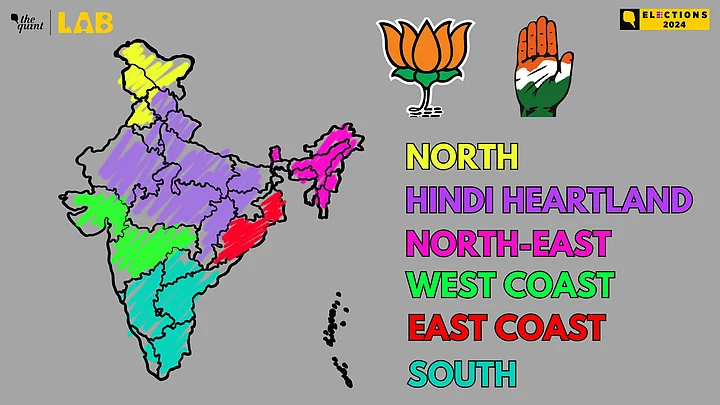The last two Lok Sabha elections saw BJP emerge as a dominant force. It became the first non-Congress party to cross the majority mark of 272 on its own. But BJP's seat share has a disproportionate reliance on the Hindi Heartland.
Similarly, the seat share of Congress, the long time-ruling party of the country, has been largely reclused to South (comprising Tamil Nadu, Karnataka, Andhra Pradesh, Kerala, Telangana, Puducherry, Andaman & Nicobar Islands, and Lakshadweep).
Let's see what the region-wise seat share from the past four Lok Sabha elections tell.
Lok Sabha Seat Share in Hindi Heartland
In Lok Sabha elections of 2014 and 2019, the Hindi heartland was at the heart of BJP’s win – contributing more than 50% of the seats won.
In 2004, the BJP secured 34.5% of seats in the Hindi heartland, a figure that surged to 78.8% by 2019, constituting 58.7% of its total 303 seats. In some Hindi heartland states, BJP made a clean sweep in 2019, including 10 in Haryana, seven in Delhi, four in Himachal Pradesh, and five in Uttarakhand.
The Hindi belt or the Hindi heartland is a central factor in the shaping of political power in India. Spanning across nine states and two Union Territories -Bihar, Uttar Pradesh, Madhya Pradesh, Chhattisgarh, Uttarakhand, Haryana, Rajasthan, Jharkhand, Himachal Pradesh, Delhi and Chandigarh - more often than not, decides who forms the government in Delhi.
In part, this is due to numerical strength — Hindi Heartland accounts for a massive 226 seats to the Lok Sabha.
Lok Sabha Seat Share in South
The southern region has been dominated by regional parties, unlike the Hindi Heartland where the national parties enjoy dominance.
BJP has been successful in managing to make inroads in South as well. Its seat share increased from 18 seats in 2004 to 29 in 2019.
In 2019, Congress made significant gains in Tamil Nadu and Kerala, when compared to its performance in 2014. Thanks to these gains, the grand old party managed to improve its national tally from 44 in 2014 to 52 in 2019.
In both, Andhra Pradesh and Tamil Nadu, the stronghold of regional parties prevailed.
Lok Sabha Seat Share in West Coast
In the west coast region spanning Gujarat, Maharashtra, Goa, Daman and Diu & Dadra and Nagar Haveli, BJP's seat share increased while Congress suffered a massive decline.
BJP maintained its stronghold in Gujarat and secured 23 seats in Maharashtra in both 2014 and 2019.
Lok Sabha Seat Share in East Coast
In 2019, BJP couldn't repeat its historic performance from 2014 in Uttar Pradesh and Bihar. But despite that it surpassed its total national tally. That was because it compensated its marginal losses in the Hindi Heartland by making big gains in the East coast.
Odisha and West Bengal, where its presence was previously minimal, saw the saffron imprint spread wider than ever before.
From winning just 3 seats in 2014, BJP secured 26 or 41% of seats in the east, including 18 in West Bengal alone.
Lok Sabha Seat Share in Northeast
In the northeast, BJP's seat share increased from four to 14 between 2004 and 2019 across eight states, while Congress' tally here went down from 11 to just four seats.
Lok Sabha Seat Share in North
The Northern states, which includes Punjab, Jammu & Kashmir, and Ladakh, is another region which helped Congress recover from its upset in 2014 to a decent tally in 2019.
BJP's seat share here hasn't seen the sharp rise that it saw elsewhere. However, this doesn't mean that it performed poorly in the North. Its seat share grew marginally because it had to share seats in Punjab with its NDA partner Shiromani Akali Dal.
In the 2024 Lok Sabha polls, BJP aims to win 370 seats single-handedly and relays slogans #Abkibaar400par for the NDA alliance. But BJP has already maxed out its potential in several regions and is facing an anti-incumbency of 10 years. This makes the 400 target an extremely difficult one.
(At The Quint, we question everything. Play an active role in shaping our journalism by becoming a member today.)
